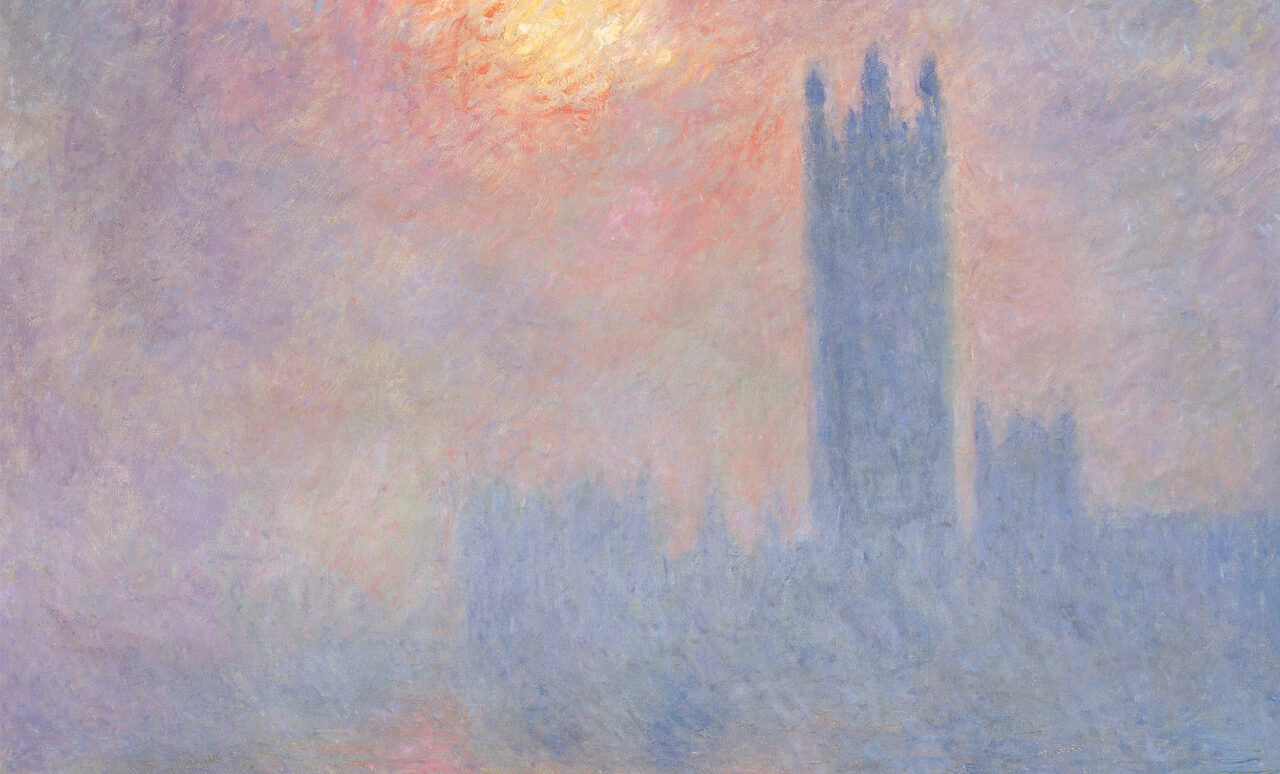Monet and London. Views of the Thames at The Courtauld Gallery

As Charles Baudelaire famously put it, “Modernity is the transient, the fleeting, the contingent; it is one half of art, the other being the eternal and the immovable.” These words come to life with vivid pertinence at the Courtauld Gallery’s exhibition Monet and London, where 21 mist-drenched visions of the Thames by the great French master stand in quiet conversation with one another. Gazing upon these mysterious, vaporous panoramas, one begins to grasp the very nature of modernity itself.
For the first time in a century, Monet’s celebrated paintings of London are brought together for public view, and they are nothing short of extraordinary. This exhibition is both a recreation of a show that Monet held 120 years ago and a homage to one that never happened. In 1904, 37 of his paintings, completed between 1899 and 1901, were displayed at his dealer’s gallery in Paris to universal acclaim. A follow-up exhibition in London was planned, but it never materialised. The logistics proved too difficult, as collectors from the original Paris show were reluctant to part with their purchases. What we have now is likely the closest we’ll ever get to experiencing that long-lost exhibition.
Curated by Karen Serres, this show reunites 18 works from that 1904 Paris event, with three additional paintings added. It’s a rare treat, an opportunity to see these works as Monet intended – together, in conversation, speaking to the fleeting quality of time and light in the capital city. The paintings focus on three sites along the Thames: Waterloo and Hungerford Bridges, and the Houses of Parliament, rendered in delicious, shifting hues of fog and smog.
Monet’s portrayal of the Thames at the dawn of the 20th century speaks not only to his fascination with light but also to the industrial atmosphere that defined the city at that time. His Waterloo Bridge, Overcast Weather is a study in urban melancholy, with its skyline punctuated by smokestacks, eerily reminiscent of Lowry’s later depictions of industrial England. Though Monet professed a love for London’s light, what he captured was something far more specific – the soft, smog-tinged glow that enveloped the metropolis in a peculiar, almost romantic haze.
Monet himself was captivated by the peculiarities of the London climate. In his letters, he described his fascination with the city’s fogs, noting their range of hues – black, brown, yellow, green, pink and purple. His challenge as a painter, he wrote, was to capture objects as they appeared through this heavy curtain of atmosphere. “Without the fog, London wouldn’t be a beautiful city,” he said, observing how it lent a grand and mysterious air to the city. In these pieces, Monet attempts to seize upon the impossible: the fleeting moment when the light breaks through the gloom, revealing, for a brief instant, the solid forms of Westminster, Waterloo Bridge, and the rippling waters of the Thames, before they once again dissolve into mist.
Perhaps no painting in the exhibition exemplifies this more exquisitely than Waterloo Bridge: Sunlight Effect. Here, a fiery orange sun pierces through the thick fog, casting radiant streaks of red across the river, which dances beneath the glow. The scene is at once vivid and dreamlike, as faint figures – a boatman, a commuter, horse carts – emerge from the haze only to fade again into the morning mist. These paintings are not depictions of the bustling life of the city, as was often the focus of Impressionist art. We are not in A Bar at the Folies-Bergère, which is found just outside this exhibition in the museum’s permanent collection. Instead, the figures of modern life here are ghostly silhouettes, barely present, as if swallowed by time.
What makes this exhibition particularly remarkable is the proximity of the paintings to their real-life counterparts. You can step out of the gallery and, within minutes, stand at the same spots Monet painted from – Waterloo Bridge, Westminster, the river itself. Yet something crucial is missing. Gone is the smog, the industrial grime that gave these scenes their eerie, candy-coloured charm. The Clean Air Acts and the decline of London’s factories have scrubbed the air and, in doing so, erased the very atmosphere Monet fell in love with.
One wonders if the artist would have been inspired to paint London as it is now: crisp, clear, and dare I say, a little too pristine. The smokestacks are gone, the fog no longer clings to the bridges, and the city has lost the ghostly shimmer of its industrial past, but here we have vivid reminders of what the city once was.
This exhibition feels like a true delight for those who live in, and love, London. The paintings possess an otherworldly allure – timeless in their beauty, yet daring in their execution. It is also refreshing to encounter a different facet of Monet’s work, a departure from the familiar masterpieces we all know so well. Here, the viewer is invited to approach with fresh eyes, to be drawn into the swirling hues and ethereal light of a London now lost to time. Don’t miss it!
Constance Ayrton
Image: Courtesy of The Courtauld Gallery
Monet and London. Views of the Thames is at The Courtauld Gallery at from 27th September 2024 until 19th January 2025. For further information or to book visit the exhibition’s website here.
























Facebook
Twitter
Instagram
YouTube
RSS